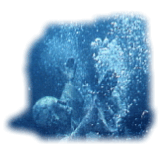|
Concentrating on only the major aircraft disappearances, Charles Berlitz barely scratched into the deep vault of cases his collaborator Dr. J. Manson Valentine had amassed. Berlitz only generally summarized types of disappearances or incidents when it came to the smaller, private or light planes. He referred to several planes “mysteriously disintegrating” while close to land and then chose to concentrate on the tragic case of Eastern Flight 401, a Lockheed L1011, in December 1972, where the death toll was over 100 people.
However, by 1974 Valentine had been keeping records of missing aircraft and ships for close to 30 years. The case I discuss here was invariably one of them. Here I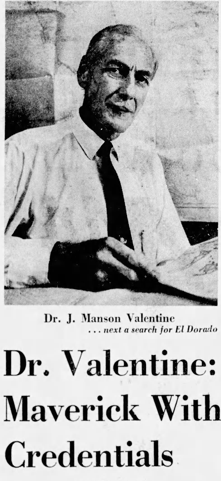 am continuing my series of old cases. I haven’t written about the details of most of them because I didn’t think readers would be interested in very old cases that were never made quite famous by the old books. But a few of the cases were inferred for being examples of certain types of unusual losses in the Triangle. This is one of them. And I think it merits some discussion since it had inspired, however indirectly, some of the prime theorists. am continuing my series of old cases. I haven’t written about the details of most of them because I didn’t think readers would be interested in very old cases that were never made quite famous by the old books. But a few of the cases were inferred for being examples of certain types of unusual losses in the Triangle. This is one of them. And I think it merits some discussion since it had inspired, however indirectly, some of the prime theorists.
For his broad range of esoteric interests, Valentine was billed in the south Florida newspapers as “the maverick with credentials.” This sometimes allowed him to say things far outside his formal training. Yet along with other scientific friends, he could bring interesting and unorthodox vantage points to some topics. For Flight 401, it was clear that the plane dropped suddenly, perhaps 1,700 feet in one turn of the radarscope before it pancaked into a swamp while on approach to Miami. Although this may be an early example of a certain type of wind sheer, Valentine believed otherwise.
This fall rate cannot be accounted for by loss of auto-pilot, stall characteristics, pilot inexperience, or even the half-power position of throttles. There must have been an atmospheric reason, quite probably magnetic anomaly of some sort. [italics Berlitz]
Following the above, Berlitz penned: “When planes and boats mysteriously disappear, or in the case of a plane, disintegrate, in this area, an increasing number of people feel a lingering doubt as to whether they have been lost ‘normally’— that is, through unusual weather conditions, pilot fatigue or error, control faults, structural or engine failure, etc., or whether the force that often seems to snatch planes out of the sky, and ships from the surface of the sea, is still in operation.”
This is indeed the feeling even today. Thus the reader being properly primed, let’s look at an old baffling case that was cause for much comment in those days before the moniker “Bermuda Triangle” was even coined. It is certainly one of those which caused a lot of people to  scratch their heads and as such it helped lay the foundation for the concept of the Bahamas Twilight Zone, the 1960s moniker used in south Florida. It was the disappearance of a private plane that eventually was found and proved to have suffered an unusual disintegration. scratch their heads and as such it helped lay the foundation for the concept of the Bahamas Twilight Zone, the 1960s moniker used in south Florida. It was the disappearance of a private plane that eventually was found and proved to have suffered an unusual disintegration.
It was the Ides of March 1956. At 3:45 p.m. the twin-Beechcraft took off from Rock Sound, Eleuthera Island, Bahamas, beginning its two hour trip back to Miami. Aboard were two very socially prominent couples. The first was James and Betty Corcoran, the second Louis and Mae Grelling. The aircraft was piloted by Clyde “Tex” Barrow, a very confident Texan.
The weather was fine. There were no problems ahead. The wealthy couples had had a great time fishing, golfing, hobnobbing on this outer Bahama island. However, they vanished. Not a word. Not a trace.
Damon Runyon Jr, then a Miami News staff writer, was the first to go into details. By March 17, some 13 military aircraft and several private planes, also 4 Naval reserve planes, known then as “weekend warriors,” had joined Bahamas conch fishermen in  search for the prominent quartet and their pilot. search for the prominent quartet and their pilot.
Corcoran was quite wealthy— black gold based in Texas oil. He lived in both Washington D.C. and Miami where, according to Runyon, he conducted most of his business. Their 3 children awaited at home under the care of a neighbor, all anxious for news.
The days of Society Page photos— the Corcorans at the Miami races.
The Grellings were Texans too, but they were growing enamored of Miami. They were wealthy on Texas oil as well. It was the era of the movie Giant, which had come to theaters just the year before in 1955 and was James Dean’s last movie. The Grellings were living it for real, though. They rented in Miami at present and maintained their home in Tyler, Texas. They had older children, and their son-in-law Gus Ralph Spence was flying to Miami to assist in the search.
As was typical of the time, their membership in certain country clubs is listed in the newspapers and the fact that Grelling, a huge fishing buff, was a member of the Key Largo Angler’s Club and the Petroleum Clubs of Dallas and Houston. Corcoran, about 65 years old, was rich enough to have married a woman about half his age. He was a former “FBI man” and was active in government circles in Washington D.C. He was a sponsor of the west coast oil pipeline. He also represented a number of groups importing horses from Argentina. The newspapers also noted that the plane had left Monday for Nassau and then Eleuthera, where the couples were staying at the exclusive multimillion dollar resort of Arthur Vining Davis’ Rock Sound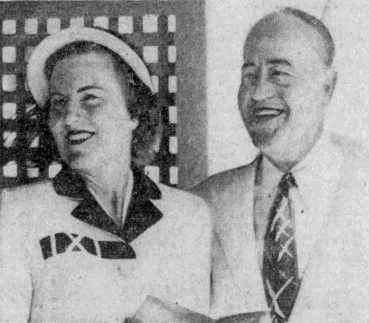 Club “and some of his huge real estate holdings.” Club “and some of his huge real estate holdings.”
Renting in Miami, the Grellings seen here at the Miami races, photo for Society news no doubt.
I think the point is made— they had all the perks of the wealthy in an era when conformity to an image and manner of lifestyle was predominant, and in the 1950s it was a very materialistic image. There is no report of the type of Beechcraft model in which they flew, but I can’t imagine less than an Beech 18 carrying all the gear the ladies would bring plus the fishing and golfing equipment the men brought.
That’s a large twin-engine plane with 5 people aboard. How did that vanish?
Runyon gives us a clue. “The search started belatedly since no flight plan had been filed by the pilot. The alarm for the missing plane wasn’t sounded until yesterday [March 16] afternoon when a preliminary search was made.”
On March 17 the hope was that with all the planes searching someone would find a clue or even the plane stranded on an island. All small fishing boats, private yachtsmen and commercial vessel were asked to keep a “weather eye” open. “There are a lot of little islands between here and Eleuthera where a plane could have landed,” declared the Coast Guard spokesman.
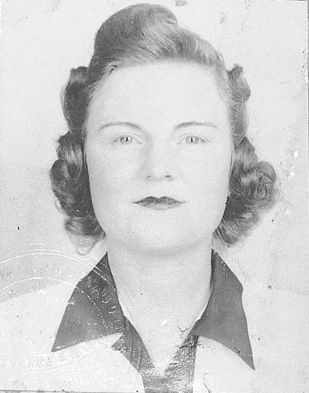 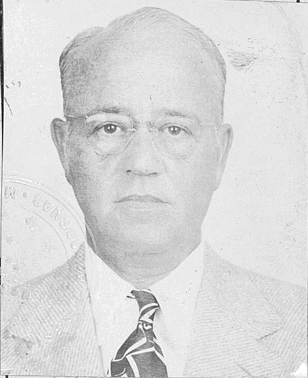
Louis Grelling and his wife Mae Kyle traveled to South America on oil business and tourism. Their passport photos, dated a few years before their disappearance, have survived.
This massive search brought a false positive on Saturday. A wrecked plane was spotted on Andros Island, and immediately this sent hope that it was the social quartet’s missing Beech. However, it turned out to be an old wreck. Arthur Vining Davis was praised for joining the search personally with a number of boats from Eleuthera. Names get dropped in a most exotic way. “The secret hideaway of Texan Clint Murchison Jr., an 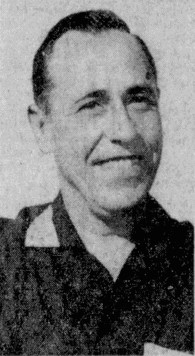 island called Spanish Cay, 20 miles northwest of Green Turtle Cay, is one place where the plane may have landed. . .The island could not be reached by radio Saturday.” island called Spanish Cay, 20 miles northwest of Green Turtle Cay, is one place where the plane may have landed. . .The island could not be reached by radio Saturday.”
A number of newspapers featured photos of the Corcoran children at home, anxiously awaiting news. It was the type of coverage meant to tear the heart out of the readership.
“Tex” Barrow, the pilot. For a pilot with real mettle there were a number of places he could have landed in an emergency, the papers reported.
Hope was still held out on Monday March 19, with both CAA officials and Coast Guard reminding people that there were a number of islands that could handle a twin-Beech of the kind Barrow was flying. The islands have poor communication, only a ham radio operator, so that it is possible the plane was there and no message had yet gotten through. It was a bit of a lame assertion considering over 20 aircraft had been searching for two days and none had reported a twin Beech sitting on a remote airfield.
The Miami News reached even further with writer Don Bonafede on March 19. Frank Madsen had been the last to see the elite couples and he said he saw the plane head north— the implication being the searchers were looking in the wrong location between Eleuthera and Miami. The plane could be on a remote island in the Abaco area.
Hope was dashed the next day. Plane wreckage was spotted in only 10 feet of water. Remarkably it was only about 40 miles northwest of Rock Sound, Eleuthera. In terms of travel, only minutes after takeoff. The first thing spotted had been a pillow bobbing in the clear water. The pilot who saw it was flying a private plane chartered by the Grelling son-in-law, Gus Spence. Then the owner of the chartered Beechcraft sent Captain Ed Stafford to go look. He spotted the remains just below the shallow surface.
Boats went out from Rock Sound, Gus Spence aboard one. There was no doubt it was the twin-Beech. Spence retrieved a floating golf bag— it had Corcoran’s name on it. A magneto brought up from the plane was identified as belonging to the twin-Beech.
David Ingram was the deputy Director of Civil Aviation in the Bahamas. He examined the site and said the plane had not ditched; it had crashed from flight. There was unusual destruction. “One of the Coast Guard workers at the scene Monday night said the wreckage was spread over an area 100 feet wide. One of the rescue workers said the wings of the plane had been torn from the fuselage, and the propellors had been torn off the motors.” (Miami Herald)
For our purposes here, that’s basically enough. The newspaper clippings entered J. Manson Valentine’s dossier and from there Berlitz perused them for his 1974 classic. In the era of the 1970s such cases were old and not really newsworthy. They inspired inferences, collectively a number inspired theories, but no names, no dates were necessary. Berlitz no doubt felt he had satisfied his point by using the big cases. Still, this remains a curious case.
Any detailed official explanation has been lost with time. The CAB files are either destroyed or misplaced prior to 1978. But there are a few things that do support the assertion that unusual disintegration of the aircraft had occurred.
The crash site was by “Findlay Cay” (Finley Cay), according to the Miami Herald. (It was declared to be only 10 miles away from Rock Sound. However, it is closer to 40 miles away). The plane must have been in flight only 10 minutes, and perhaps wasn’t even at cruising altitude yet. There had not been a massive explosion in the sky else the wreckage would not have been in a tight grouping. This leaves two other possibilities.
- 1. Implosion. Yet an implosion only happens during convective activity. There was no such weather condition this close to Eleuthera.
- 2. The plane was slapped straight down to the sea. It just suddenly dropped.
Both Spence and Stafford, then the Coast Guard, were amazed that no one had seen the wreckage the first day, since the area had been searched. Stafford blamed it on the color of the aircraft blending with the aqua color of the shallow bottom. But we should wonder whether it was simply so close to Rock Sound the area had not been carefully searched at all.
There were no bodies. The sea had taken its toll. The total destruction and death (presumed) of all aboard is unusual, especially considering it was only minutes from takeoff.

The Miami Herald gives us this map, but today we can do a little better.
|

